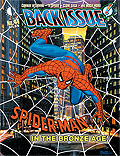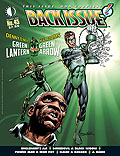Wednesday, May 13, 2015
Discuss: When Creators Unite... or Not.
Doug: I ran across a tweet from @comicsalliance late yesterday afternoon and wanted to bring the subject over here for discussion. The basic gist of the article (please make the jump, then return here for conversation) is that in 1978 a group of comic book creators sought to form a guild. That didn't happen. But what's interesting is the compensation they sought for contracted work (below), and how those page rates look when adjusted for inflation.
Doug: And, just for the sake of setting your mind, here's a link to Mike's Amazing World of Comics and the books that would have been on sale in May 1978.
Doug: So what do you think? Given all that we've heard of work for hire contracts, freelancing, and most recently Gerry Conway's posts on compensation for character creation, do you have an opinion here? Thanks in advance for sharing those thoughts today.
Subscribe to:
Post Comments (Atom)




















































13 comments:
Just to clarify, are those the actual rates they were getting in 1978? Or are those what they would be today when adjusted for inflation?
Because if that is what they were getting back then, it was pretty darned good for 1978. If that's what it is today, then it's OK, but not spectacular. I think most pencilers can do about a page a day, so $300 a day is nothing to sneeze at I suppose, even by today's standards.
William --
In the article linked, it states that those prices were a wish list, and that most if not all of today's creators could only dream of such page rates - so yes, for 1978 those demands would have been lucrative to say the least.
Doug
I'm surprised the colorist would make almost as much as the writer. I like it though, as great colorists like Glynis Wein can make the visual experience of comics so enjoyable.
The Marvel covers that stand out this month are Captain America by Zeck + McLeod (dramatic scene) and Master of Kung Fu by Gulacy (moody). For DC it's Doorway to Nightmare by Kaluta, and Warlord by Grell. I just picked up the 5 issue series of Doorway to Nightmare for cheap. The inside art is uniformly bland, but the covers by Kaluta are excellent.
Seems to me this was a bad time to start making demands, with the DC implosion in 1978, but it's too bad they couldn't get the guild off the ground a couple years later when Byrne, Perez, Miller and others were all fan favorites and comics were selling.
Maybe its worth pointing out those page rates might well be a starting position, a statement of intent? I mean, if comic creators wanted to negotiate with publishers as an organised group, it wouldn't make sense to start with a lower rate they might be willing to accept.
On those covers - Marvel's John Carter is great, Gil Kane and Rudy Nebres are a match made in heaven. Also agree with Garrett about Kaluta and Gulacy... but those two had pretty much given up on doing interiors by then, and generally I'd say those covers taken as a whole are a pretty good indication of how US comics suffered from many of the better creators of the 70s leaving the field; by '78 a better deal was well overdue.
Of course, freelancers are hard to organise as a group...
-sean
I remember Jim Shooter, when he was still blogging, had a post about this. He had a slightly more reserved view of the whole matter, but his opinion was/is obviously colored by the fact that he was either already Marvel's EiC at the time, or at least assistant editor, i.e., "management."
I know both Marvel and then DC both introduced royalties for creators a few years later, so this sweetened the deal for a lot of writers, artists, etc. down the line, but they weren't, unfortunately, retroactive not across the board benefits for everyone on the creative side.
Personally, though, just reading the proposed rates and knowing very little of the details, I still say it's too bad they didn't actually form their guild so they could engage in some collective bargaining, and make their proposed rates a reality.
...And looking at those covers, I can say that I had almost none of the super-hero stuff, as I was still pretty deep into my Archie, funny animal phase. There's a few titles I did pick up later, and for some reason, I don't know why, I had that issue of Marvel Premiere - not a bad little story, with nice art by Tom Sutton.
Hiya,
If I'm correct, and for once I might be, all of this came up just before the 'DC Implosion'. Work became a lot more scarce and the Guild sort of faded away.
I think Shooter had a couple of columns about this at his blog.
pfgavigan
I picked up lots of the comics published that month as back issues. But the only one I picked up brand new was 'Batman' #302, featured the "wirehead killers" as villains:
http://www.dcindexes.com/features/comic.php?comicid=3832
It's a shame that the comic creators couldn't organize and get better pay. I know of a few who had health issues later on and had to rely on donations and the like to pay medical bills.
Regarding the covers for that month, I always get surprised how bad my recollection is. I was sure that Firestorm must have come out years before some of the other mags that month. I was collecting Avengers heavily at that time, and for the life of me cannot figure out why I wouldn't have picked up an XMen until about two years later.
That "What If" probably holds some value now... in light of yesterday's news spoiler.
Hiya
Just popped back in to share a few views.
It would be really nice to have information regarding the relative profit from each book at this time. How much were they earning in after expenses and such.
Years earlier, Martin Goodman authorized the payment of one hundred and fifty dollars per issue to the Robert E. Howard estate for the rights to published Conan the Barbarian. He then insisted that Thomas's first choice for penciller would have to be changed to a younger, less experienced and much less expensive talent.
Thus John Buscema gave way to Barry Smith. Thank god! No slam against Buscema, but the Limey (joke, joke, joke) grew as an artist and the comic grew with him.
I guess my point being is this, if the licensing fee cut the profit on the book that much that Goodman, who was an intelligent man that had started off life as far behind the eight ball as you could and built himself a small but significant publishing house, was concerned enough to put a less known artist on the book, that must have been a significant amount of money in regards to profit.
The Goodman family is not extinct, one of his grandchildren has even expressed interest in entering the field. Business records and recollections might still exist. It would be wonderful to get a look at the dollar and cents side of the business.
pfgavigan
I wonder how comics would've looked if these creators- including Paul Levitz, Neal Adams, Jim Shooter, Frank Miller, Walt Simonson and Chris Claremont according to the article- had packed up and formed a 1978 version of Image comics? You could add Starlin, Chaykin and Grell in there, as they jumped to independent publishers in the '80s anyway. Quite the potent lineup of Bronze Age creators in top form.
Yes, but the problem there, Garrett, is that the direct market that worked so well for Image was still very much in its infancy back in '78. And the distribution system that served underground comics was in decline, so pros looking for regular income would have had to aim for some sort of newsstand publication.
In the late '70s, that was really just Heavy Metal, which in fact did feature a lot of top US comics types like Wrightson, Chaykin and Kaluta, and was a much better mag (at least for the first half dozen years or so) than a lot of people think, imo. Someone should do a post about it on BAB (hmmmm... Doug or Karen, would you be interested?)
Anyway, newsstand business was/is a really tough nut to crack, requiring serious investment; in fact, Marvel and DC ended up needing the direct market to survive, so its not surprising that creators turned to other fields instead.
-sean
300 bucks for one page??? Man, I gotta learn how to draw! Seriously, though, I think this highlights the issue of proper renumeration for creators whether they are artists, writers or colourists. Correct me if I'm wrong but there isn't any union or other such body which looks after the interest of our creative geniuses when they are in need of financial aid.
- Mike 'got minimum wage for minimum effort' from Trinidad & Tobago.
I'm I dyed in the wool union guy. Add to my own convictions the heartbreak and trauma I've seen many of my artistic heroes (Kirby, Siegel and Shuster, et al) endure at the hands of the big comic book companies and this is a no-brainer for me. Organizing under a guild, just like pros in the movie/tv/animation industry, would assure proper credit, compensation, and even health insurance for creators, young and old. I even wrote a short article about my feelings a few years ago.
The month the guild was proposed produced quite a few comics I love, and many I read off the racks or close to the date of publication. These include: Thor #274 (tv crew in Asgard/Death of Balder by Thomas/Big John B), Amazing SM #183 (a real Bronze Age classic with the Rocket Racer! by Wolfman and Andru), Defenders #62 (the immortal "Defender for a Day" by David Anthony Kraft and Sal B), Kirby's Devil Dinosaur #5, and Claremont and Byrne's X-Men #112 (the team captured by Magneto, which i think was the first "new" X-Men I ever owned or read (and re-read endlessness)).
Post a Comment